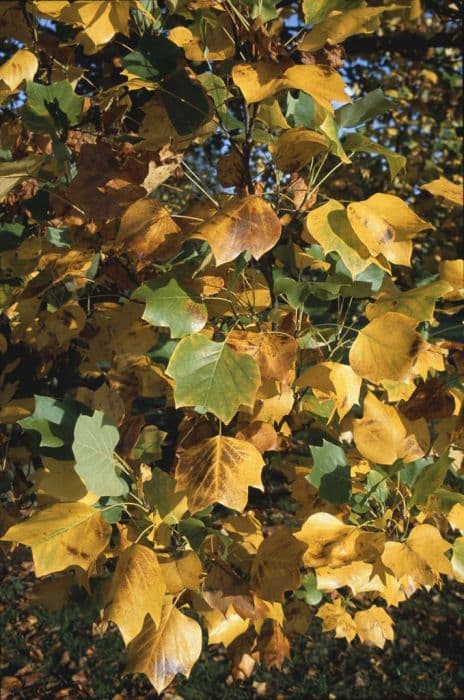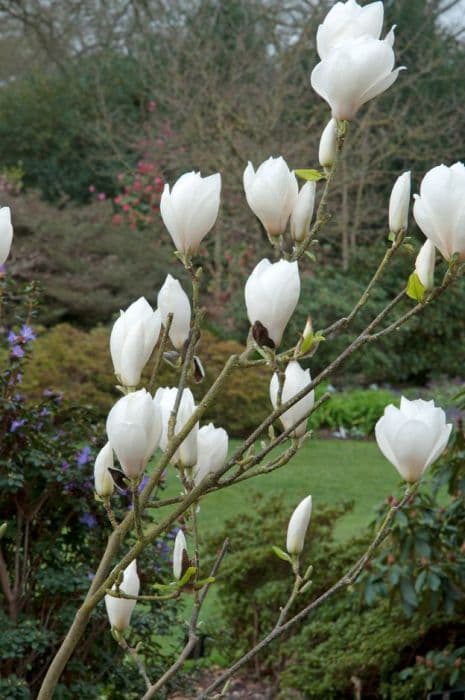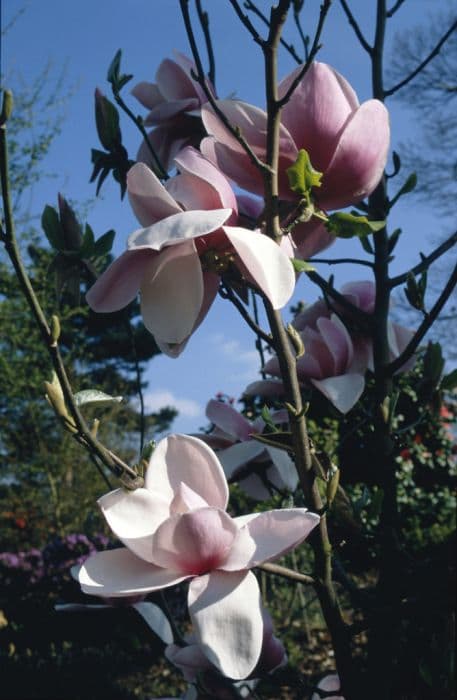Saucer magnolia 'Brozzonii' Magnolia × soulangeana 'Brozzonii'

ABOUT
'Brozzonii' is a large spreading deciduous shrub flowering before the ovate leaves open. Flowers white, tinged purple at the base outside, up to 20cm in width, opening in mid and late spring
About this plant
 Names
NamesSynonyms
Saucer Magnolia, Tulip Magnolia, Chinese Magnolia, Japanese Magnolia.
Common names
Magnolia × soulangeana 'Brozzonii'.
 Characteristics
CharacteristicsLife cycle
Perennials
Foliage type
Deciduous
Color of leaves
Green
Flower color
Pink
Height
20 feet (6 meters)
Spread
20 feet (6 meters)
Plant type
Tree
Hardiness zones
5
Native area
Cultivar
Benefits
 General Benefits
General Benefits- Aesthetic Appeal - The Saucer Magnolia is known for its large, showy flowers which add significant ornamental value to landscapes.
- Seasonal Interest - It provides an early burst of blooms in spring, often before the leaves emerge, marking a dramatic change of seasons.
- Landscape Versatility - Saucer Magnolias are adaptable to a variety of landscape settings from residential gardens to parks.
- Wildlife Attraction - The flowers attract pollinators such as bees, which are important for maintaining healthy ecosystems.
- Shade Provision - As a moderately large tree, it can offer shade in gardens and urban areas, creating pleasant outdoor spaces.
- Enhances Property Value - Attractive landscaping, which includes flowering trees like the Saucer Magnolia, can have a positive effect on property values.
- Cultural Symbolism - Magnolias are often considered symbols of grace and beauty, and can imbue a space with these associations.
 Medical Properties
Medical PropertiesThis plant is not used for medical purposes.
 Air-purifying Qualities
Air-purifying QualitiesThis plant is not specifically known for air purifying qualities.
 Other Uses
Other Uses- Leaf Litter for Composting: The fallen leaves of the Saucer Magnolia can be collected and added to compost piles where they decompose and enrich the compost with nutrients.
- Educational Tool: Saucer Magnolia can be utilized in educational programs to teach botany, particularly the study of flower structures and pollination processes owing to its large and prominent flowers.
- Culinary Garnish: The petals of the Saucer Magnolia, although not commonly used, can be employed as an ornamental garnish for sophisticated culinary dishes, adding a touch of elegance.
- Natural Dye: The bark and flowers of the Saucer Magnolia may be used to produce a natural dye for fabrics or artwork, resulting in unique earth tones and patterns.
- Photographic Subject: Owing to its beautiful blossoms, the Saucer Magnolia serves as a spectacular subject for photographers, especially in spring when the flowers are in full bloom.
- Artistic Inspiration: Artists may use the form, color, and overall beauty of the Saucer Magnolia as inspiration for paintings, drawings, and other forms of art.
- Horticultural Training: Pruning techniques can be practiced on Saucer Magnolia as their size and branching pattern make them ideal for educational purposes in horticulture.
- Tannin Extraction: The bark of the Saucer Magnolia contains tannins, which can be extracted and used in the tanning process for leather.
- Craft Material: Dried Saucer Magnolia flowers and leaves can be used in various crafts, including potpourri, floral arrangements, or as natural decor in handmade paper making.
- Ceremonial Use: In some cultures, branches and flowers of the Saucer Magnolia may be used in ceremonial or religious events as symbols of purity and elegance.
Interesting Facts
 Feng Shui
Feng ShuiThe Saucer Magnolia is not used in Feng Shui practice.
 Zodiac Sign Compitability
Zodiac Sign CompitabilityThe Saucer Magnolia is not used in astrology practice.
 Plant Symbolism
Plant Symbolism- Persistence: Magnolias are known for their ability to withstand harsh conditions, thus symbolizing durability and perseverance.
- Femininity: With their graceful and delicate appearance, they are often associated with the softness and purity of femininity.
- Elegance: The Magnolia × soulangeana 'Brozzonii's sophisticated shape and poise make it a symbol of elegance and grace.
- Dignity: Magnolias carry themselves with a strong presence; therefore, they represent dignity and self-respect.
- Nobility: Historically, magnolias have been linked with nobility and are often found in royal gardens, symbolizing high status and pride.
- Love of Nature: Being one of the first plants to bloom in spring, magnolias symbolize an appreciation for the natural world and its beauty.
 Water
WaterSaucer Magnolia should be watered deeply once a week during the growing season, especially if there hasn't been significant rainfall. The amount of water should generally be about 1 to 1.5 gallons for young trees, increasing the amount as the tree matures, ensuring moisture reaches deep into the root zone. During hot and dry periods, watering frequency should increase to twice a week, while during cooler or rainy seasons, it should be reduced. It's important not to overwater, as standing water or very wet soil can lead to root rot. Always check the soil moisture by feeling it a few inches deep; it should be moist but not saturated.
 Light
LightThe Saucer Magnolia thrives best in full sun to partial shade. It prefers a spot that receives at least 4 to 6 hours of direct sunlight daily, but it can also tolerate some light afternoon shade, especially in hotter climates. Avoid placing it in deep shade, as this can lead to reduced flowering and a less vigorous plant overall.
 Temperature
TemperatureSaucer Magnolia trees are hardy in zones 4 through 9 and can tolerate a wide range of temperatures, but they perform best when the temperature is between 70 to 85 degrees Fahrenheit. They can withstand winter chill down to about -10 degrees Fahrenheit and enjoy the moderate warmth of spring and fall. However, prolonged exposure to temperatures over 90 degrees Fahrenheit can stress the tree.
 Pruning
PruningPruning a Saucer Magnolia is primarily done to shape the tree and remove any dead or diseased wood. It should be done after the tree finishes blooming in late spring to avoid cutting off any of the current year's blooms. Light pruning and the removal of any damaged branches can be done at this time. Major pruning should only be done every few years to maintain the shape and health of the tree.
 Cleaning
CleaningAs needed
 Soil
SoilThe Saucer Magnolia prefers a well-draining soil mix rich in organic matter with a slightly acidic to neutral pH, typically between 5.5 to 7.0. A blend of loam, peat moss, and compost makes an ideal soil mix for this plant.
 Repotting
RepottingSaucer Magnolias are typically planted in the ground rather than potted, but young trees can be repotted every few years as they grow, or when they become root-bound.
 Humidity & Misting
Humidity & MistingThe Saucer Magnolia does well in average outdoor humidity levels and doesn’t require specific humidity conditions, but it does appreciate a location that isn't too dry.
 Suitable locations
Suitable locationsIndoor
Place in bright indirect light, ensure ample space.
Outdoor
Full sun to partial shade, shelter from harsh winds.
Hardiness zone
4-9 USDA
 Life cycle
Life cycleThe Magnolia × soulangeana 'Brozzonii', commonly known as the Saucer Magnolia, begins its life cycle with seed germination, which requires exposure to warm and cold stratification periods to break dormancy. After germination, the seedling stage follows, where the plant develops its first true leaves and establishes a root system. As it grows into a young plant, the Saucer Magnolia enters the vegetative stage, with rapid growth of branches and leaves, preparing for the flowering phase. The mature stage is marked by the plant's ability to produce the iconic large, showy flowers, typically blooming in early spring before leafing out. Once the flowering stage concludes, the plant produces fruit that contains seeds, completing the reproductive cycle. Finally, the Magnolia 'Brozzonii' reaches the senescence stage, where growth slows, and the plant eventually dies, although it can live and continue to flower for decades with proper care.
 Propogation
PropogationPropogation time
Spring-Early summer
The most popular method for propagating the Saucer Magnolia, Magnolia × soulangeana 'Brozzonii', is through softwood cuttings taken during late spring to early summer. To do this, select a healthy young branch and cut a piece about 4 to 6 inches (10 to 15 centimeters) in length, ensuring there are at least two to three sets of leaves. Remove the leaves from the lower half of the cutting and dip the cut end into a rooting hormone powder to encourage root growth. Then, plant the cutting in a well-draining potting mix, and keep it moist and in a warm place with indirect sunlight. A plastic bag can be placed over the container to maintain humidity. Roots typically develop in a few weeks, after which the new plant can eventually be transplanted outdoors.









